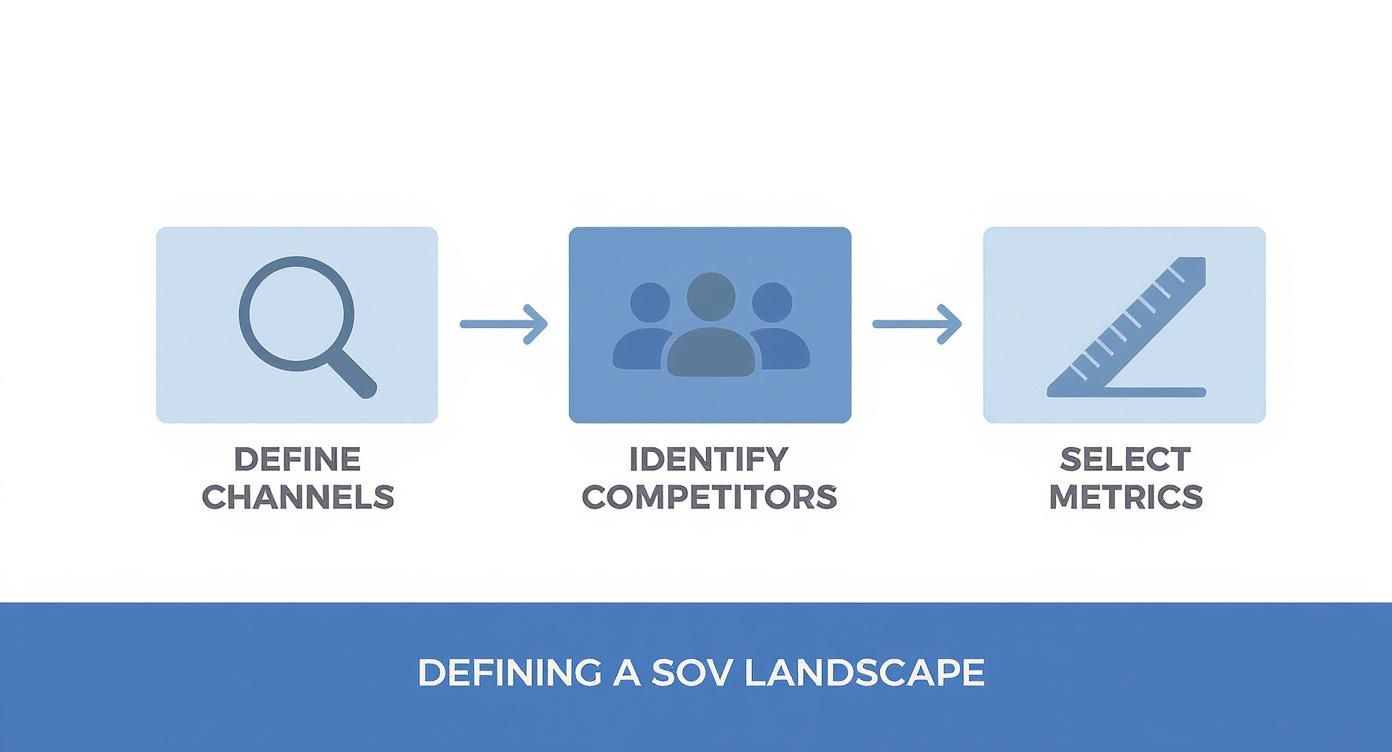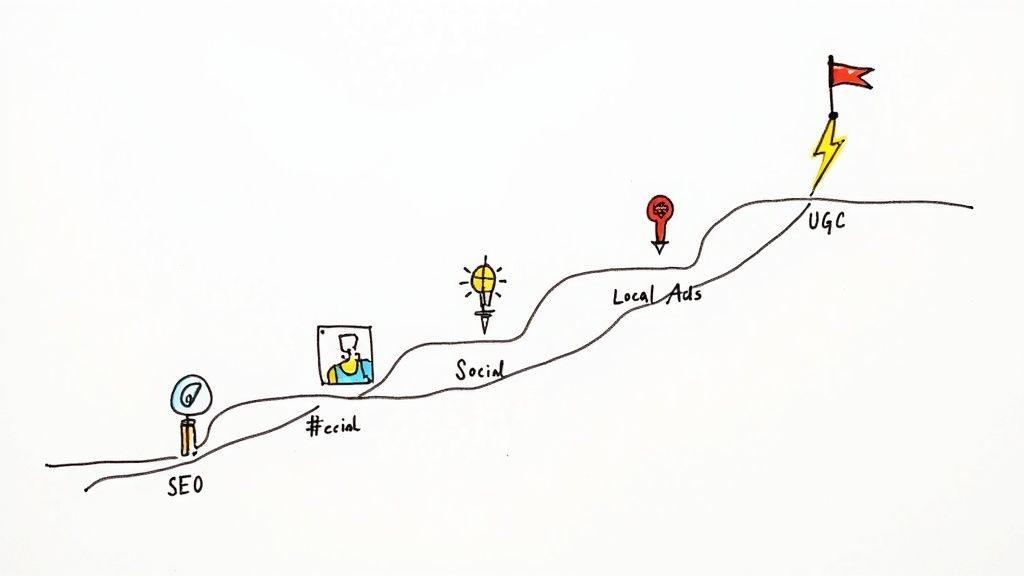The basic math for Share of Voice is simple. You take your brand’s metric (like mentions or keyword impressions), divide it by the total market's metric, and multiply by 100.
If your brand gets 500 social media mentions and the total conversation across all competitors is 10,000 mentions, your Share of Voice (SOV) is 5%.
But this formula hides the real problem. Most guides assume you're a big player who can easily track the "total market." For everyone else, that's impossible. The secret isn't tracking everything; it's defining a battlefield you can actually win.
Why Share of Voice Is More Than a vanity Metric
Share of Voice used to be a simple metric tied to ad spend. Now, it’s a direct measure of your brand’s visibility against your competitors across the channels that matter. It answers one vital question: "Of the conversation happening, how much of it do we own?"
Think of your target market as a conversation. Your SOV is your slice of that conversation. This isn't about bragging rights; it's a leading indicator of market share and future growth.
It’s About Authority, Not Just Awareness
A high SOV directly impacts revenue. It shapes how consumers perceive you and what they decide to buy. When your brand consistently appears in search results, social feeds, and industry discussions, you’re not just visible—you’re building authority.
This metric gives you a clear lens to:
- Benchmark performance objectively: See exactly how you stack up against key rivals, not just your past performance.
- Spot growth opportunities: Find channels or topics where your competitors are weak, creating an opening for you.
- Measure campaign impact: Know for sure if your marketing is actually making a dent in the market conversation.
The core idea is simple: a brand that commands a greater share of voice than its share of market is likely to grow. This principle, "Excess Share of Voice" (ESOV), has been shown to correlate strongly with market share gains.
SOV's New Frontier: AI Answers
The concept of SOV has evolved. It's no longer just about your PPC impression share or organic keyword rankings.
The new frontier is conversational AI.
Platforms like ChatGPT and Gemini are becoming the first stop for consumer research. Your presence—or absence—in these AI-generated answers is the next battleground for visibility.
For modern marketing teams, understanding your AI Share of Voice is becoming non-negotiable. Knowing if your brand is cited as the "best tool for X" is the ultimate measure of authority. As users turn to AI for direct answers, the brands that dominate this new conversation will win.
First, Define a Winnable Battlefield
You can't calculate a meaningful SOV without first defining your competitive landscape. It’s incredibly easy to burn hours tracking competitors that don’t actually matter for your specific goals.
Your competitors are not who you think they are.
That direct business rival might be a ghost in organic search, where a niche industry blog is eating your lunch. The goal isn't to track every player—it's to track the ones who matter in the spaces where your customers are paying attention.
This process forces you to connect your SOV metrics to real business objectives. Are you trying to dominate a specific set of non-branded keywords? Or is your focus on owning a particular hashtag conversation? Each goal requires a different battlefield map.
Identify Your True Competitors, Channel by Channel
You must break this down by channel. Your competitor on Google for "AI-powered SEO tools" is different from your main rival for industry chatter on X (formerly Twitter).
- For SEO: Don't just list your business suspects. Use an SEO tool to see who actually ranks for your top 10-15 target keywords. You'll likely find that content publishers or niche blogs are your true SEO rivals.
- For Social Media: Look for the brands that consistently command your target audience's attention. Use social media competitive analysis tools to see beyond surface-level noise.
- For PPC: This is more straightforward. Your competitors are the other domains bidding on your keywords. Google Ads shows you exactly who you're in the auction with.
Defining your landscape isn’t about making a giant list. It's about pinpointing the 3-5 key players who are most visible on the specific channels you’ve decided matter most.
Mini Case Study: A SaaS Startup Redefines Competition
Imagine a B2B SaaS company wants to calculate share of voice for organic search. Instead of trying to take on giants like HubSpot, they narrow their focus to "CRM for small law firms."
Suddenly, their competitor list changes completely.
It’s no longer other massive CRMs. It’s the top 5 domains ranking for that specific cluster of long-tail keywords. This includes two niche legal tech blogs and only three direct software competitors. By defining a winnable arena, their SOV calculation becomes an actionable measure of progress.
The Formulas and Tools for Modern SOV Calculation
Calculating Share of Voice today means getting granular. You need the right tools to pull accurate data for each channel.
The core formula, however, remains simple.
It all boils down to this: (Your Brand's Metric / Total Market Metric) x 100.
The trick is knowing which metric to plug in for each channel—and where to find it. You can't just mash organic search visibility and social media mentions into one number.
The infographic below outlines the first steps: defining channels, picking competitors, and choosing the right metrics.

Following this workflow ensures you gather the right data that aligns with your goals.
Calculating Organic Search SOV
For organic search, the gold standard metric is keyword visibility. This tells you what percentage of all possible organic clicks you're capturing for a specific group of keywords.
You absolutely need a solid SEO tool for this.
- Tool of Choice: Semrush or Ahrefs are non-negotiable.
- The Process:
- Define a list of your most important, high-intent keywords.
- Set up a position tracking project, adding your domain and your top 3-5 search competitors.
- The tool automatically calculates a visibility score for everyone based on rankings and search volume.
- Plug your visibility score into the SOV formula against the total visibility of you and your chosen competitors.
Finding Your Paid Search SOV
With paid search, the platforms hand you the data. The metric you need is Impression Share.
Impression Share is the percentage of impressions your ads received compared to the total number they could have received. If your Impression Share is 40%, your SOV for that campaign is 40%. Simple.
You can find this data directly inside your Google Ads account by adding the "Competitive metrics" columns to your reports. For a deeper look at different measurement approaches, see this complete guide on share of voice measurement.
Measuring Social Media SOV
Social media is about conversation, so you measure brand mentions.
- Tool of Choice: A social listening platform like Brandwatch is essential here.
- The Process: Track mentions of your brand, your competitors' names, and relevant hashtags. The tool will pull in these conversations.
- Calculation: (Your Total Mentions / Total Industry Mentions) x 100.
But just counting mentions is outdated. A more sophisticated approach also factors in metrics like your engagement rate to understand the quality of your visibility, not just the quantity.
How to Turn Your SOV Data into a Growth Strategy
You've calculated your Share of Voice. Maybe it's 15%. On its own, that number is useless. The value comes from putting it into context and using it to build a smarter marketing roadmap.
Your SOV data is proof of whether your campaigns are moving the needle. It shows where competitors are leaving gaps and if you’re punching above your weight.
Go Beyond a Single Snapshot
A one-time SOV calculation is a single frame in a movie. To find actionable insights, you must track it over time. Set up a simple dashboard or spreadsheet to monitor your SOV weekly or monthly.
This transforms your analysis from static to dynamic. You can start spotting trends and asking better questions:
- Did our SOV spike during our last product launch?
- Did a competitor’s new feature release cause our numbers to dip?
- Is our organic search SOV growing faster than our social media SOV?
By mapping your SOV against your marketing calendar, you can draw direct lines between your actions and their impact on market visibility.
The Power of Excess Share of Voice (ESOV)
Here's where it gets interesting. The most powerful way to interpret your SOV is by comparing it to your Share of Market (SOM). This relationship is called Excess Share of Voice (ESOV).
The formula is simple: ESOV = Share of Voice (SOV) - Share of Market (SOM).
A positive ESOV means your brand’s presence is bigger than its current market share—a strong predictor of future growth. If your SOV is 20% but your market share is only 10%, your ESOV is +10%. You're outperforming the market and are primed to grow.
A landmark 2013 analysis by Binet and Field found that, on average, a brand gains about 0.5% in market share for every 10% of ESOV. This principle turns SOV from a vanity metric into a strategic forecasting tool. You can get more insights on this from this in-depth guide to marketing analysis.
Mini Case Study: A DTC Sneaker Brand
Imagine a direct-to-consumer sneaker brand, "SoleCraft," with a 5% market share. They run a three-month influencer campaign and track their social media SOV.
- Before Campaign: SOV was 4%, for a -1% ESOV. They were underperforming.
- During Campaign: SOV shot up to 9%, creating a healthy +4% ESOV.
- After Campaign: SOV settled back to 7%, but they held onto a +2% ESOV.
The data tells a clear story. The campaign didn't just create a temporary blip; it successfully boosted their visibility beyond their market position. Their next step is to analyze which influencers drove the biggest spikes, perhaps using the most accurate AI visibility metrics software, and reinvest in what worked.
Actionable Strategies to Increase Your Share of Voice

Knowing your SOV is only half the battle. The real value comes from actively growing it. Measurement without action is just trivia.
Forget generic advice like "create great content." To boost your SOV, you need specific, channel-focused strategies that chip away at your competitors’ visibility.
Steal Visibility in Organic Search
The fastest way to grow your SEO Share of Voice is to find where your competitors are winning and strategically take that ground.
- Target Competitor-Owned Keywords: Use an SEO tool to find high-intent keywords where a competitor ranks on page one, but you don’t. Your mission is to create content that is demonstrably better—more detailed, better structured, and more up-to-date.
- Build Topic Clusters: Stop writing one-off blog posts. Develop clusters of content around a central "pillar" page. This signals to Google that you're an authority on the entire topic, boosting visibility for a whole set of related keywords.
Dominate Social Conversations
On social media, SOV is won by being part of the conversation, not just broadcasting to it.
- Engage in Relevant Discussions: Use social listening to find unbranded conversations about problems your product solves. Jump in and offer genuine advice without a hard sell.
- Amplify User-Generated Content (UGC): Actively encourage and showcase content created by your customers. UGC is a massive SOV multiplier because it’s authentic and expands your reach through your users’ own networks.
Your goal isn't just to be seen; it's to become the go-to resource. When you consistently show up with valuable contributions, your Share of Voice naturally expands.
Mini Case Study: A Local Plumber’s SOV Win
A small plumbing company in Chicago felt invisible online. Their organic search SOV for "emergency plumber chicago" was a meager 4%.
Instead of a broad SEO campaign, they went all-in on local search. They optimized their Google Business Profile with every service and dozens of photos. Then, they hustled to gather 50+ five-star reviews in three months. At the same time, they ran highly targeted local Google Ads focused on a tight 10-mile radius.
The result? Their local search SOV jumped to 22% in one quarter. More importantly, this translated directly into a 35% increase in appointment bookings from online channels. This shows how a narrow focus can build a dominant share of voice in advertising where it matters most.
Common Questions About Calculating SOV
Here are the most common roadblocks marketers hit when putting SOV into practice.
How Often Should I Calculate My SOV?
The right cadence depends on your industry and channels.
For fast-moving markets, you might track social media SOV weekly, especially during a campaign. For organic search, a long game, monthly or quarterly tracking is plenty. SEO rankings don't swing wildly day-to-day.
The most important thing is consistency. Pick a schedule and stick to it to build useful, trended data.
What if My Competitors Are Too Big?
Don't try to out-muscle a massive competitor on a national scale. It's a losing battle.
Instead, redefine the arena. Shrink the battlefield to a space you can win.
- Niche Down: Forget "CRM software." Own the SOV for "CRM for small law firms."
- Go Local: A local business can dominate SOV within a specific city, even with a national chain nearby.
- Focus on Long-Tail Keywords: Go after specific, lower-volume keywords that bigger players ignore. They add up.
By narrowing your focus, you can achieve a high SOV with an audience that actually matters. It's about being the most influential voice in the right room.
Can I Calculate One Blended SOV Score?
It’s tempting, but it's a terrible idea. The result is almost always misleading.
An impression on Google Search has a fundamentally different value than a mention on X. Mashing them together with arbitrary weighting just hides the truth in the data.
It is far more actionable to track SOV for each channel separately. Have an "Organic Search SOV," a "Paid Search SOV," and a "Social SOV." Pull these distinct metrics into a single dashboard to get the full picture. This allows you to make sharp, effective decisions for each part of your strategy.
Ready to measure your brand's visibility where it matters most? AI SEO Tracker is the only platform that shows you exactly where your brand appears in AI-generated answers across ChatGPT, Gemini, and more. Stop guessing and start winning the “best X” queries by tracking your AI Share of Voice. Get a clear view of your competitive landscape and an action plan to dominate the new era of search.

